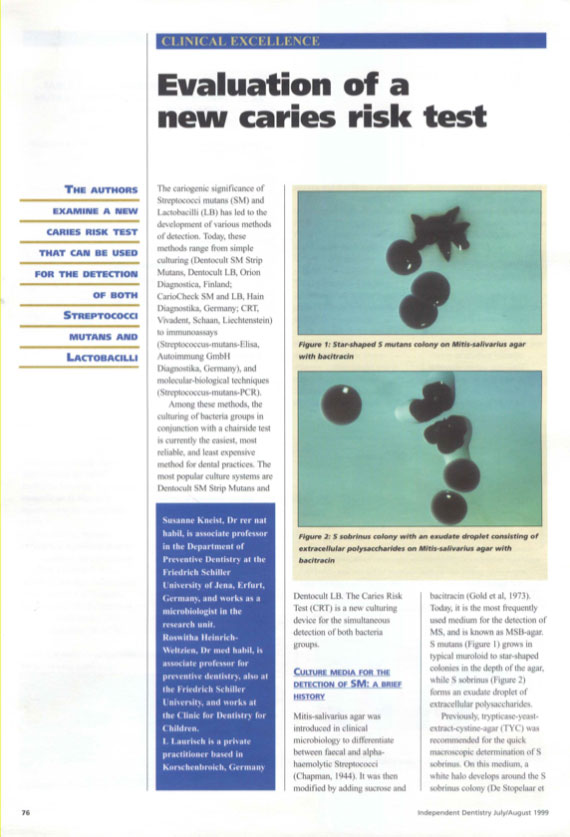KariesScreenTest is the successor to the CRT® bacteria. It is based on the same patented highly selective agar for the detection of Streptococcus mutans. Publications based on the CRT® bacteria are therefore also transferable to the caries screen test.
Gerodontology. 2008 Mar;25(1):26-33. doi: 10.1111/j.1741-2358.2007.00184.x.
A simplified caries risk test in stimulated saliva from elderly patients.
Sánchez-García S1, Gutiérrez-Venegas G, Juárez-Cedillo T, Reyes-Morales H, Solórzano-Santos F, García-Peña C.
The CRT Bacteria test shows similar results to those of the CLT test in subjects 60 years of age and over.
Pediatr Dent. 2004 May-Jun;26(3):231-9.
Microbiological screening for cariogenic bacteria in children 9 to 36 months of age.
Barsamian-Wunsch P1, Park JH, Watson MR, Tinanoff N, Minah GE.
All sampling methods were adequate for microbial risk assessment tests in children under 3 years of age. MS was a stronger indicator of caries status than LB.
Zusätzlich die Veröffentlichungen „Evaluation of a new caries risk test“ wie oben angeführt.
Further references to the saliva test:
Burke F. J., Cheung S. W., Mjör I. A., Wilson N. H. F.: Restoration longevity and analysis of reasons for the placement and replacement of restorations provided by vocational dental practitioners and their trainers in the United Kingdom; Quintessence Int. 1999; 30: 234-242
Featherstone J. D. B.: The caries balance: The basis for caries management by risk assessment; Oral Health Prev. Dent. 2004; 2 Supplement 1: 259-264
Giannoni M., D `Amario M., Gatto R., Barone A.: Some tools for the identification of high risk individuals. A review; Minerva Stomatol. 2005; 54 (3): 111-127
Günay H., Dmoch-Bockhorn K., Günay Y., Geurtsen W.: Effect on caries experience of a long-term preventive program for mothers and children starting during pregnancy; Clin. Oral Invest. 1998; 2: 137-142
Kneist S., Chemnitius P., Borutta A.: Die mikrobielle Mundhöhlenbesiedlung von Müttern in Beziehung zur frühkindlichen Karies ihrer Kinder; Quintessenz 2006; 57(6): 607-615
Kneist S., Heinrich-Weltzien R., Fischer T., Stösser L.: Mikrobiologische Speicheltests – mehr als eine Motivation?; Quintessenz 1998; 49: 139-148
Kneist S., Stürcke R., Heinrich-Weltzien R.: Möglichkeiten und Grenzen der Gruppenprophylaxe; Oralprophylaxe & Kinderzahnheilkunde 2004; 26: 157-161
Li Y., Caufield P. W.: The fidelity of initial acquisition of mutans streptococci by infants from their mothers; J. Dent. Res. 1995; 74: 681-685
Näpänkangas R., Salonen-Kemppi M. A. M., Raustia A. M.: Longevity of fixed metal ceramic bridge prostheses: a clinical follow-up study; J. Oral Rehabil. 2002; 29: 140-145
Pienihakkinen K., Jokela J., Alanen P.: Risk-based early prevention in comparison with routine prevention of dental caries: a 7-year follow-up of a controlled clinical trial; clinical and economic aspects; BMC Oral Health 2005; 23; 5(1):2
Rosén B., Olavi G., Birkhed D., Edvardssom S., Egelberg, J.: Effect of different frequencies of preventive maintenance treatment on dental caries: five-year observations in general dentistry patients; Acta Odontol. Scand. 2004; 62: 282-288
Thibodeau E.A., O`Sullivan D. M. : Salivary mutans streptococci and incidence of caries in preschool children; Caries Res. 1995; 29: 148-153
Vehkalahti M., Nikula-Sarakorpi E., Paunio I.: Evaluation of salivary tests and dental status in the prediction of caries increment in caries-susceptible teenagers; Caries Res. 1996; 30: 22-28


